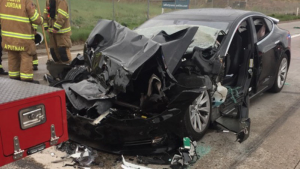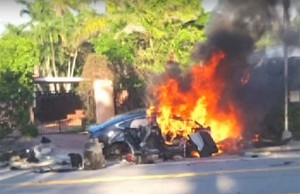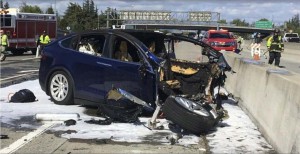
The NTSB is investigating a third crash involving a Tesla vehicle using Autopilot at the time of the collision.
A Tesla Model S sedan that crashed into the back of a fire truck in Utah last week was operating in semi-autonomous Autopilot mode, the battery-electric automaker has confirmed, though the company has also tried to shift blame to the 28-year-old driver by noting that she repeatedly took her hands off the wheel and admitted being distracted immediately before the crash occurred.
The incident is the latest in a series of accidents involving Tesla vehicles in the U.S. and abroad and could raise new concerns about the safety of the automaker’s products – especially those using Autopilot which Tesla CEO Elon Musk has hailed as a potentially life-saving feature.
The latest crash occurred when a Model S slammed into a parked fire truck at around 60 mph. The female driver suffered a broken foot. She subsequently told authorities that she was driving in Autopilot mode. Tesla engineers on Wednesday accessed the vehicle’s black box and confirmed that statement, though they also revealed that the driver had taken her hands off the wheel for as much as 80 seconds immediately prior to the crash.
Investigators from the National Highway Traffic Safety Administration have been dispatched to Utah to launch an investigation and will “take appropriate action based on (their) review,” the agency stated.
(Tesla’s California plant shutting down for six days later this month. Click Here for the story.)

The National Transportation Safety Board launched a second investigation into a Tesla crash. This time a Model S burst into flames after spinning into a wall.
That makes at least three the number of federal investigations into Tesla crashes currently underway. The National Transportation Safety Board is probing an incident in California that killed the driver of a Model X SUV that also was operating in Autopilot mode. The NTSB also is examining a recent Model S crash in Florida that resulted in a fire that killed two teenage boys and injured a third.
Separately, Swiss authorities this week said they are investigating a fatal Tesla crash that set the vehicle on fire.
While Teslas may use no gasoline, they draw power from lithium-ion batteries that use chemistry that can ignite if they are damaged. The subsequent fires can be difficult to put out, one reason that most major airlines now restrict the shipment of lithium-powered devices and batteries in their cargo holds.
CEO Musk has tried to downplay that risk, however, noting that thousands of gasoline cars catch fire each year and such events are generally ignored or downplayed by the news media.
“Those stories generally never go past local news outlets,” echoed Fred Lambert, publisher of the pro-electric vehicle website Electrek, “but when a Tesla vehicle is involved, it suddenly makes national news.”
He has also fired back at report on the fatal California Model X crash, pointing out that the driver failed to take control of the vehicle despite repeated warnings from the Autopilot system.
In the initial investigation of last week’s Utah crash the driver took her hands off the wheel on “more than a dozen instances,” according to data shared with police in the town of South Jordan. She retook manual control only after getting a visual alert from the system.
(Click Here for more about Musk looking beyond Model 3 problems, but creating some headache in the process.)
According to the police report, “About 1 minute and 22 seconds before the crash, she re-enabled Autosteer and Cruise Control, and then, within seconds, took her hands off the steering wheel again.” It concluded that, “She did not touch the steering wheel for the next 80 seconds until the crash happened.”
The Autopilot system has generated a significant amount of controversy since it was introduced in late 2015. The following spring saw the technology involved in a Florida crash that took the life of a former Navy SEAL. NHTSA initially put the blame on the driver, Joshua Brown, accusing him of being distracted and not making any effort to avoid crashing into a truck that pulled in front of his Model S. But a separate probe by the NTSB also faulted Autopilot for not recognizing the white truck because it was backlit by a bright Florida sky.
One of the key issues concerns the capabilities of Autopilot. Early on, critics contend, Tesla billed the system as virtually autonomous, triggering owners to post a rash of videos showing them operating their sedans hands-free. One even was shown climbing into the back seat. And Musk and his former wife were pictured also driving along with their car being operated hands-free.
After driver Brown was killed in Florida, Tesla made significant hardware and software changes and the company has taken a position that appears to downplay the ability of Autopilot to operate without the driver’s hands on the wheel. The company now makes it clear a motorist needs to remain attentive and ready to grab control back quickly in the event of a potential problem.
But during an earnings conference call this month, Musk indicated a fully autonomous – as in hands-free – version of Autopilot is close to release.
Musk also took aim at media who have been reporting on recent crashes involving Tesla Autopilot, in particular, and more advanced autonomous vehicles, more generally. That includes an Uber SUV that struck and killed a pedestrian near Phoenix in March.
“It’s really incredibly irresponsible for any journalist with integrity to write an article that would lead people to believe that autonomy is less safe — which might lead people to turn it off and then die,” Musk declared.
(To see more about NTSB’s ongoing Tesla crash investigations, Click Here.)
With two of the new federal safety probes focusing on the Autopilot system, the ability of the Tesla Autopilot system to keep motorists safe will now be under review.


Autonomous driving is fine if you 1) don’t take your hands off the wheel, 2) don’t drive in bright sunlight, or 3) don’t drive where people push their bikes across the road. Sounds like George Soros’ fault.
LMAO…except the push for expanding public testing of the technology has support from both sides of the aisle and from some very Conservative investors, too.
Tesla’s are a relatively new for of propulsion, hence the attention they receive when they crash and many vehicles may catch fire in a crash but they are more easily extinguished than a lithium fire.
“…noting that thousands of gasoline cars catch fire each year and such events are generally ignored or downplayed…”. Perhaps the media assumes that most people already know that gasoline burns. They may not be fully aware that batteries, or at least the type of battery used in most electric cars, also burn, and apparently quite readily. Does anyone know what class of fire extinguisher should be used on this type of battery fire?